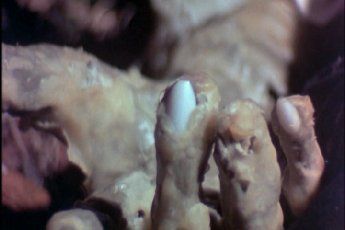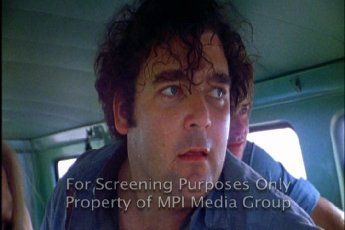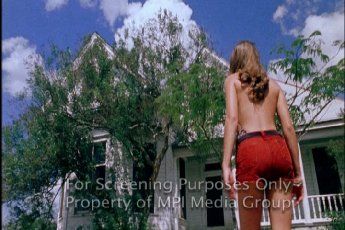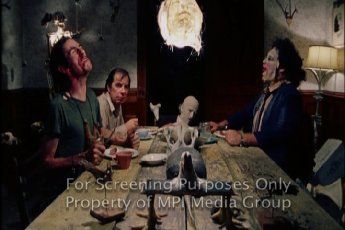The Texas Chain Saw Massacre (1974) DVD Review
Written by Rosie Fletcher
DVD released by Dark Sky Films


Directed by Tobe Hooper
Written by Kim Henkel and Tobe Hooper
1974, Region 1 (NTSC), 83 minutes, Rated R
DVD released on September 26th, 2006
Starring:
Marilyn Burns as Sally Hardesty
Allen Danziger as Jerry
Paul A. Partain as Franklin Hardesty
William Vail as Kirk
Teri McMinn as Pam
Gunnar Hansen as Leatherface
Edwin Neal as The Hitchhiker
Jim Siedow as The Cook
John Dugan as Grandpa


Review:
The Texas Chain Saw Massacre (TCM) was originally released in 1974, causing international controversy, but also widespread exhilaration. I didn’t get a chance to see it until a number of years later, mainly because I wasn’t actually alive in 1974. But while I couldn’t be part of the initial furore surrounding this film, its significance didn’t escape me — even before I’d seen it, to me, it was the stuff of legends.
On the 26th October, Dark Sky Films will release this restored and re-mastered version of the original ’74 picture, packed with extras and remixed in stereo sound.
If you haven’t seen this film, it’s about time you did.
Beware of spoilers in the following review.


There’s little argument that TCM is an influential film. Some credit it with the beginnings of the “final girl” plot device used in so many stalk and slash movies of the ‘70s and ‘80s, others say TCM is responsible for making the “masked killer” format so popular as a horror device — whether you accept these accolades or not, it’s easy to find numerous examples of films influenced by TCM. For its time, its budget and in its era, TCM was an exceptional accomplishment. But opinion is divided over whether or not it stands up now, regardless of influence, as a decent, scary horror movie.
The opening sequence of TCM gives a fair indication of what you can expect from the film to come:
A black screen and the sound of something — digging perhaps — and breathing. Brief shots, lit by a camera flash, of parts of a rotting corpse — fingers, bones, dead eyes. In the background a radio report tells of grave robbers in the area — it’s hard to make out the details, but you can tell there are unspeakable acts being related (as the report goes on you hear fractions of other stories, other acts of cruelty — mentioned, but not dwelt on — teenage girls killed, an 18 month old child chained up in an attic). Texas dawn and the camera focuses on the rotting head of another corpse against the rising sun. We pan out and down slowly and see another head, some hands, clothed legs wrapped around some sort of monument — two bodies, incomplete. It’s hard to make out clearly exactly what you’re looking at.
And the camera stays focused on this image for far, far too long.
TCM is a visceral film. It’s one that appeals to your senses and your instincts far more than to your intellect or your emotions.
It’s a film in three acts. The first act is the slow, painful build up. A girl and her disabled brother drive with their friends to see their old family home (stopping on the way to make sure their grandfather’s grave hasn’t been exhumed). Not much happens but everything points to impending doom.
From the opening shots of the dead armadillo in the road, the film is full of nasty little reminders that things aren’t going to be okay: the laughing drunk, bellowing out “I see things!”, the stench of the slaughter house and the close-up of the half-dead drooling cow, the teeming spider’s nest in the old family home, the sounds of laughter — harsh and distorted so they almost sound like screams, the tooth on the porch. Tension is laid on thick. When the hitchhiker cuts Franklin, in the only real climax of the first act, I was a bundle of nerves.
In short: in the first act nothing happens, and everything feels unbearable.


The second act begins very suddenly when Leatherface appears for the first time. Framed by a doorway, the heads of dead animals mounted on either side of him, he silently — and efficiently — clubs one of the kids with a sledgehammer and drags him out of the doorway, closing the metal door behind him with a bang. It’s brutal, sudden, shocking and strange. The film goes from a slow burner, full of tension, to a set of workman-like kills. The kids are slaughtered one after another. There’s no chase, no shocks, no peaks or troughs — there’s almost no tension at all, just pure brutality. Once the killing begins you’re given no time to reflect or to relax, you’re not afforded any moments to grieve, and there are no points where you’d normally giggle having been shocked. Like cows in an abattoir, the kids are killed rapidly, one after another. Leatherface never speaks — he makes sounds like an animal. The characters die as cattle and, in this way, are dehumanised too.
The characters in TCM don’t have a great deal of dialogue and they aren’t especially carefully drawn. They elicit little sympathy. By denying you any real sympathy or engagement with the characters you’re denied an emotional involvement with their deaths. The lack of emotional attachment to the individuals allows you to see the action as a whole. The violence is all the more brutal because it’s removed from one particular set of individuals — it’s applied to people in general. To return to the abattoir: watching cattle killed in a slaughter house is affecting, not because you know the cows personally. The cold brutality, the volume, the relentlessness, the indiscrimination: these things are shocking. The fundamental idea of the inalienable value of human life is shaken. It’s a huge thing. We all believe that we’re more than beasts, that our lives have value and meaning. And most of us believe our deaths will have meaning, too — at the very least a battle, a struggle, a show of strength. A rapid, random bolt through the brain isn’t a very romantic way to go — to deny one’s humanity in death is almost to deny it in life, too.
Wheelchair-bound Franklin is the most memorable character and stands out, mainly because he’s obstructive, whiny and difficult. He doesn’t want to be left behind. He’s clearly frightened when the others don’t come back, he’s rendered helpless by his impairment and has to suffer humiliation as a result of it. He’s also the most human in the way he relates to the hitchhiker. He makes an attempt to relate to him and, in a way, the two are parallels — outcasts within the social units, the “runts”. I didn’t feel sad or sorry when Franklin was killed but it was a more shocking and unexpected scene than the earlier deaths and, although his demise is equally quick, it’s exacted more along the lines of killer/victim than butcher/beast. His death marks the start of the third act.


This final act is the hardest to stomach. The sound track is almost exclusively screaming or backed by screaming — sometimes with a little dialogue, sometimes with the roar of the chainsaw. But for a full 30 minutes (yes, I timed it) there are only two or three occasions where you aren’t blasted by the sound of screaming. It’s almost intolerable.
Whatever else is going on on-screen, the relentless barrage is deeply unpleasant — it’s irritating, it’s excruciating and it induces a constant state of anxiety. It’s in no way enjoyable and I can understand the desire to switch off — it’s some of the most uncomfortable cinema I’ve ever sat through.
There are shocks in the third act and some innovative and disgusting scenes. The worst for me was “the cook” speaking to the girl and reassuring her gently while jabbing her hard with a stick. Scenes between the family are, at points, farcical and this isn’t something I feel really works in this film. It adds a strong sense of unreality and it detracts from the sheer nastiness of the rest of the movie. Then scenes are frequently revolting and are equally relentless, but the inclusion of dialogue (bearing in mind there’s virtually none in the second act) and some of the extreme weirdness is a bit jarring. Still, the incessant screaming coupled with some of these incredibly perverse images are a way to reach a peak in the tension built up during the rest of the film.
Even at the end you’re denied a climax, and in denying you this you’re also denied the release of tension that usually follows. The film ends on the iconic image of Leatherface swinging his chainsaw wildly.
TCM isn’t a fun film to watch — it’s an attack on the senses and it goes out of its way to make you uncomfortable. You’re denied any dramatic tension, the fun of guessing what’s going to happen, the pleasure of empathy. It defies logic, abandons ideas of character and story arc. Images and sounds are thrown at you hard, ceaselessly and with no respite. Walking away from TCM I feel tired and shaken — thrown.




Video and Audio:
This is a high quality transfer from the original 16mm negatives. It’s completely cleaned up so there are no flickers or spots, but the colours still retain their washed-out feel. It’s a shame there’s no comparison between old and new footage on the DVD because the clean-up job is pretty amazing. You can get an idea of how grainy the old version was by looking at the theatrical trailer and some of the deleted scenes. There’s no doubt that Dark Sky has done an excellent job but I can’t help feeling that perhaps something is lost. The poor quality flickery picture gave TCM a slight “home movie” feel to it, that some how made the action even more real and made the audience a little bit like voyeurs. I miss that a little bit.
You have the option of watching this in Dolby Digital 5.1, 2.0 Surround sound and the original mono. It sounded fine to me.


Special Features:
Feature disc
- Theatrical trailer from the Bryanston and Newline releases.
- TV and radio spots for the film (again, from Bryanston and Newline)
- Two sets of audio commentary, one from from David Gregory, director of the Shocking Truth documentary, Marilyn Burns, Paul Partain, Alan Danziger and art director Robert Burns, the other from Tobe Hooper, cinematographer Daniel Pearl and Gunnar Hansen.
- Subtitles in English and Spanish
Bonus Disc
- Texas Chain Saw Massacre: The Shocking Truth Documentary
Pretty much essential viewing for those interested in the film, it tells the story of the making of TCM and the subsequent financial issues caused by dodgy backers and ambiguous agreements (meaning most of the cast were never paid more than a pittance for the film, despite the fact that it was financially very successful). It’s interesting to see the little inconsistencies between people’s memories of what happened during the shoot, and art director Robert Burns, is particularly funny in his obvious healthy disdain for the film.
- Flesh Wounds Documentary
In seven sections about TCM related things. The best bits are about TCM cinematographer Daniel Pearl, and how he got on board the project, actor Edwin Neal (who played the hitchhiker) who seems like a very odd but interesting, possibly schizophrenic bloke, and Gunnar Hansen (Leatherface) and his subsequent career as a writer. There’s some overlap with other extras, for example the “This Old House” section is basically covered by Hansen’s tour, and “The Good Doctor” section is covered by the “Creating Grandpa” extra.
- A tour of the TCM house with Gunnar Hansen
A look at the house in 1993, and again in 2000. It’s become a sort of restaurant and looks completely different obviously. The Easter bunnies lining the stairs were just plain weird.
- Deleted scenes and outtakes
Interesting and worth seeing — if only because of the slight strangeness of seeing extra parts of something that’s basically the stuff of legend. Might have been nice to have a voice over for some of the early shots with no sound, but this doesn’t detract especially.
- Bloopers reel
I have to say that this was just plain weird. Perhaps because I’ve seen TCM many, many times and find it a very disturbing watch, shots of Franklin falling out of his wheelchair, or Grandpa slipping part way down the stairs, just feel freaky rather than funny. I can’t separate the actors on set from the characters, so it all just feels a bit sick and twisted.
- Outtakes from The Shocking Truth
Bits they cut from the documentary. Cast members talking about funny things that happened on set are far less creepy than shots of these things in the bloopers reel. Frequently funny, it makes a short, but welcome, addition to the documentary.
- Dr. W. E. Barnes Presents Making Grandpa
Stills of teenage actor John Duggan being cast and made up to look like Grandpa, along with a few shots from the dinner scene. Interesting although information overlaps with one section of the Flesh Wounds documentary, so unless you’re particularly interested there’s not much point in watch both (and the documentary as a whole is better).
- Stills gallery
- Posters and stills from the film.
Grades: |
|||||
| Movie: |  |
 | |||
|---|---|---|---|---|---|
| Video: |  |
||||
|
Audio: |
 |
||||
| Features: |  |
||||
| Overall: |  |
||||

This page includes affiliate links where Horror DNA may receive a small commission at no extra cost to you.



